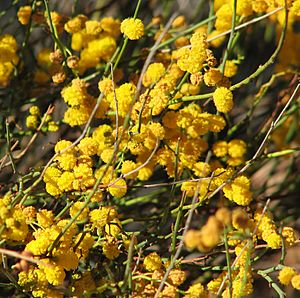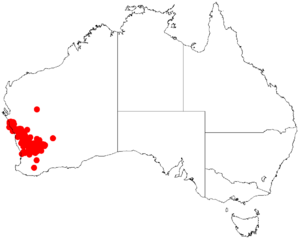Acacia restiacea facts for kids
Quick facts for kids Acacia restiacea |
|
|---|---|
 |
|
| Scientific classification | |
| Genus: |
Acacia
|
| Species: |
glaucoptera
|
 |
|
| Occurrence data from AVH | |
Acacia restiacea is a special type of Acacia plant, also known as a wattle. It belongs to a group called Alatae. This plant is originally from Western Australia.
What It Looks Like
This plant is a small shrub that doesn't have many leaves. It usually grows to be about 0.5 to 1.5 meters (about 1.5 to 5 feet) tall. It often looks a bit like a rush plant. It can grow straight up or spread out along the ground.
Most Acacia restiacea plants have many stems. These stems are green and have a slightly dull, waxy look (called glaucous). They are round and have fine lines on them. Sometimes, you might see small, fern-like leaves near the bottom of the stems.
The plant also has special parts called phyllodes. These are like flattened stems that act like leaves. They are rarely seen and look similar to the stems themselves. They are about 7 to 25 millimeters long (about 0.3 to 1 inch) and very thin, only about 0.7 millimeters wide. This plant blooms from late winter to late spring, usually between August and November. When it flowers, it produces bright yellow blooms.
How It Was Named
The first official description of Acacia restiacea was made by a botanist named George Bentham in 1842. A botanist is a scientist who studies plants. His description was part of a larger work by William Jackson Hooker. This work was published in a science journal called the London Journal of Botany.
Later, in 2003, another scientist named Leslie Pedley changed its name to Racosperma restiaceum. But then, in 2006, it was moved back to its original group, the Acacia genus. This shows how scientists sometimes change plant names as they learn more about them.
Where It Grows
You can find Acacia restiacea in several parts of Western Australia. It grows in the Mid West region, then spreads through the Wheatbelt, and reaches into the Goldfields-Esperance areas.
It can be found as far north as Northampton. In the south, it grows near the coastal suburbs of Perth. To the east, it reaches places like Westonia. You can also find small, separate groups of these plants near Tambellup and Menzies.
This plant likes to grow in different kinds of places. It often grows in rocky or gravelly soil. This soil is usually found over or around granite rocks.

